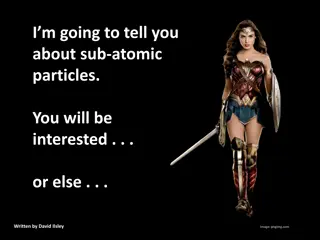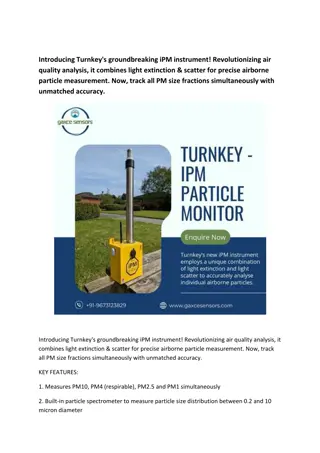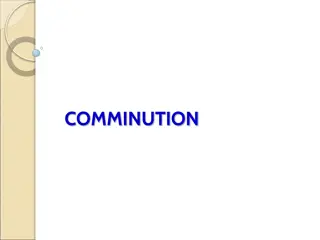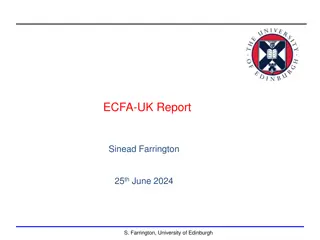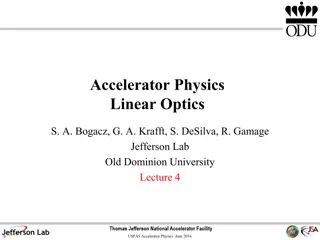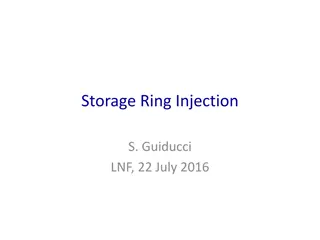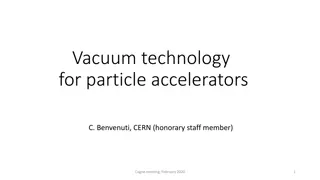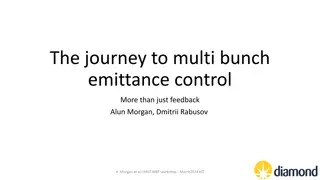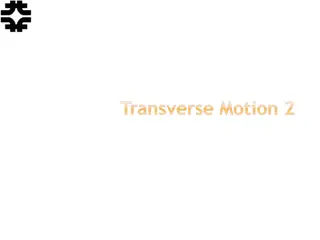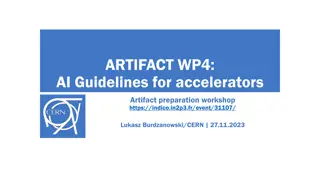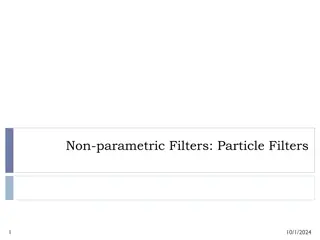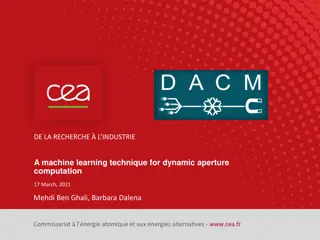Understanding and Addressing Instability in Particle Accelerators
In this document, E. Shaposhnikova from CERN discusses observations and cures for instability in particle accelerators. The content covers types of instabilities, observations like direct and indirect effects, and possible cures such as modifying the source, passive and active damping, and changing machine parameters. The importance of theory in addressing instabilities is highlighted, along with the classification of instabilities based on various criteria like longitudinal or transverse planes and single or multi-bunch scenarios. Specific observations from the LHC are also detailed, emphasizing the significance of detecting and managing transverse instabilities in high-energy physics experiments.
Download Presentation

Please find below an Image/Link to download the presentation.
The content on the website is provided AS IS for your information and personal use only. It may not be sold, licensed, or shared on other websites without obtaining consent from the author. Download presentation by click this link. If you encounter any issues during the download, it is possible that the publisher has removed the file from their server.
E N D
Presentation Transcript
Instability observations and cures E. Shaposhnikova (CERN) Benevento, 19.09.2017 Acknowledgements: T. Argyropoulos, H. Bartosik, T. Bohl, L. Carver, H. Damerau, A. Lasheen, J. E. Muller, J. Repond, H. Timko, D. Valuch 8/21/2024 1
Outline Types of instabilities Instability observations: direct indirect Cures: modifying the (identified!) source ( passive damping) active damping change in beam and machine parameters theory is very important (scaling!) 8/21/2024 2
Observations depend on instability type V Instabilities can be classified in many ways. By plane: longitudinal or transverse (vertical or horizontal), but interplay between planes could be also important: H&V coupling: LHC; FCC-ee? (A study of longitudinal effects on transverse Landau damping by I. Hofmann) Single- or multi- bunch: driven by broad- (narrow-) band impedance with 2Q/ r < (>) Tbb ( r and Q are impedance frequency and quality factor) Single- and multi- beam (e-cloud, beam-beam in Session 4) Hadron and lepton beams (Impedance and instabilities in lepton colliders by M. Migliorati and in hadron machines by B. Salvant, Challenges in impedance and instabilities computation for new generation light sources by S. Persichelli) different damping (SR) and instability (CSR) mechanisms different bunch length and impedance frequencies of interest H Z Tbb 8/21/2024 3
OBSERVATIONS 8/21/2024 4
Instability observations Direct and usually undesirable (unexpected, appear when parameters are pushed beyond the design ) particle losses beam dump, quench of SC magnet, ring activation beam quality deterioration - uncontrolled emittance blow-up Measurements of instability parameters for model/impedance benchmarking and search of cures Thresholds (intensity, energy, emittance) Growth rates Spectrum BLM of the quench LHC, 16L2, 12.08.2017 43.5 s A. Lechner measurements simulations bunch length [s] bunch intensity Blow-up due to single bunch instability at 450 GeV in CERN SPS (A. Lasheen) 8/21/2024 5
Instability observations LHC Beam 1 LHC Beam 2 H H V V A. Lechner Recent transverse instability in LHC associated with beam losses in location 16L2 (and magnet quench in this particular case on 12.08.2017). BBQ (turn-by-turn base-band tune) signal during event showing coherent oscillations in both transverse planes. 8/21/2024 6
Transverse instability detection in LHC LHC transverse feedback (ADT) measures bunch-by-bunch, turn-by-turn transverse position of all circulating bunches with sub-micrometer resolution A computer system (ADTObsBox) provides access to data: 1 Gbit/s per 1 pickup (16) Data are available for offline analysis in form of buffers. Computationally heavy analysis can be performed directly in the Box using CPUs or GPU accelerators (M. E. S der n et al., IPAC 17, MOPAB117). Triggers, timings Typical cases of data analysis: Offline:data collected over a network, stored locally and analyzed later Semi-online: data collected over network, analyzed by script in the control center Online: analysis performed directly in the Box, high rate data never leave the Box Fibres with pickup data 8/21/2024 7
Transverse instability observation in LHC Pickup Kicker Beam Transverse Automatic logging: - processed performance data (damping time, tune) - instability signatures - processed spectra CCC fixed displays: - damping time, tune - transverse activity - transverse instability feedback Beam Position Module Digital signal processing Power amplifier ObsBox 1 Gb/s per pickup, 6 million turns buffer Bunch by bunch transverse observation system (known as ADTObsBox) ObsBoxBuffer PosMor (64k) Obs64k (64k) Inj32k (32k) InjOsc (4k) Obs4k (4k) Users semi-online analysis in while still in CCC: - MDs - activity after injection - scrubbing - tune shift observation - coupling correction - collimator impedance Offline analysis, download in CCC, analyze later: - MDs - long time inj. osc. storage - drift observation Subscribers outside CCC: - RF, BI ALLADTCopra ADTSpectrum ALLADTDiag Beam parameter and damper performance extraction Online instability detection, transverse activity monitor Online spectrum and tune Processed data damping time, bbb tune Processed data Instability trigger, list of unstable bunches Processed data transv. motion spectrum Raw position data for offline use Technical network and CMW Real time ADT transverse instability detection system: G. Kotzian, M. S der n, D. Valuch 8/21/2024 8
Transverse instability detection in LHC: example of instability at injection Injection Raw pickup data Developing coherent activity Oscillation amplitude Trigger will be sent here Real time ADT transverse instability detection system: G. Kotzian, M. S der n, D. Valuch 9
Transverse Mode Coupling Instability losses CERN SPS, 26 GeV/c HEADTAIL simulations measurements: m=1 fast slow slow Measured threshold For long bunches the TMCI threshold: Nth ~ L| | Zeff/ y fast Measured instability island and modes are reproduced in simulations H. Bartosik et al., IPAC 14 8/21/2024 10
Head-tail instability growth rates as a function of chromaticity Effective impedance is a convolution of Z with longitudinal spectral density SPS 26 GeV/c Q20 optics ( ) and chromatic frequency = 2 f = / , is chromaticity, - slip factor Q26 optics By varying on can sample frequency dependence of the transverse impedance Amplitude of peak in FFT C. Zannini et al., IPAC 15 ( ) Q 2 eff Re Z 8 N r c 1 Instability growth rates used for evaluation of transverse impedance , 0 dip 2 = 1 2 z 8/21/2024 11
Longitudinal instability due to loss of Landau damping during LHC ramp No controlled emittance blow-up due to issue with phase loop for Beam2 Measurements of bunch length with Beam Quality Monitor (T. Argyropoulos) 8/21/2024 12
LHC: observation of longitudinal oscillations LHC Longitudinal diagnostics tool (beam phase module): Bunch-by-bunch synchronous phase is measured turn-by-turn and transmitted through a fiber optic link ObsBox: Captures data streamed and permits processing and buffering of full rate data for around 5 minutes CERN Control Center fixed display: Bunch-by-bunch synchronous phase corrected for an accuracy of less than 0.1 deg, displayed every 10 s. 8/21/2024 13
Instability thresholds: loss of Landau damping in LHC Gives also measurement of (ImZ/n)eff (~0.08 Ohm) Single bunches 5 2 ? ?? 1 4 ? 5 4 ?? ? ?? ?5 LHC bunches ?? Bunch length shrinkage during physics @ 6.5 TeV J. E. Muller et al., 2015 8/21/2024 14
Spectrum of unstable single bunches Measurements allow to detect resonant frequencies of longitudinal impedances with high R/Q Long single bunches injected into ring with RF off Low momentum spread: slow debunching and fast instability Measure bunch profiles and use projection of spectra Spectrum of unstable bunch Bunch profile (SPS 26 GeV/c) 8/21/2024 15
Spectrum of multi-bunch beam (coupled-bunch instability) = (n + l M) 0 + m s, - < l < , n=0, 1 M-1 is the coupled-bunch mode number, M is number of equidistant bunches in the ring and m=1, 2, is the multipole number,n + l M pr On the spectrum analyzer negative appear at [(l+1)M n)] 0 - m s Similar spectrum at l M + n and (l+1)M n, but above transition internal synchrotron sidebands correspond to impedance at higher frequency and external at lower (opposite for < t) Spectrum envelop with maximum at fmax : if fmax < 1 fr < 1/ , if fmax >1 fmax ~ fr Instability due to a narrow-band resonant impedance at r = 0 pr. The unstable spectrum of multi-bunch beam has components at fmax 8/21/2024 16
CURES 8/21/2024 17
Cures: acting on instability source (1/2) Step 1: Identification of guilty impedance EM simulations Lab measurements Beam based measurements (Session 3, beam measurements of ring impedance, talks by A. Lasheen and R. Nagaoka) Missing impedance can be found from quadrupole frequency shifts 8/21/2024 18
Cures: acting on instability source (2/2) LHC RF fingers Step 2: Impedance reduction Redesign, shielding reduction of Rsh/Q (C. Vollinger talk) Damping reduction of Rsh (and Q) with Rsh/Q ~ const, helps for coupled-bunch instability, less for a single bunch (posters by P. Kramer and J. Repond on crucial HOM damping in the SPS TW RF) TWC HOM coupler shifting HOM fr Shields for SPS vacuum flanges 8/21/2024 19
Cures: active damping Feedback for reduction of fundamental cavity impedance covers usually a few revolution lines; exists in all CERN accelerators Feedbacks for specific modes (Transverse feedback systems for multi- bunch beam diagnostics and instabilities suppression by A. Drago; for CERN PS with its 5 RF systems Observation and active damping of longitudinal coupled bunch instabilities by H. Damerau)) Wide-band feedbacks for damping an intra- bunch motion. Examples: PSR damping ring up to 180 MHz; prototype for suppression of e-cloud and TMC instabilities in the SPS up to 1 GHz (Wide-band feedback systems to diagnose and suppress intra-bunch motion in accelerators by J. Fox) Slotted line kicker of SPS HBW Damper (E. Montesinos et al.) 8/21/2024 20
Damping of coupled-bunch instability with dedicated coupled-bunch feedback Feedback Feedback off off Feedback Feedback on on CERN PS, high intensity 2x1011 p/b (LHC nominal - 1.3x1011 p/b. Damping using wide-band Finemet cavity (H. Damerau) The feedback filters the synchrotron frequency side-bands of frev harmonics from hRF/2 to hRF and feeds them back to beam with the appropriate phase (on harmonics from frev to fRF/2). 8/21/2024 21
Cures: active damping (2/2) Instability thresholds and growth rates can be significantly affected by beam control which includes transverse dampers, phase and radial loops, one-turn FB and feedforward systems. Practically any realistic simulation of beam acceleration should include effect of various loops Accurate theoretical and simulation models are important but difficult to build (Vlasov solvers and macroparticle simulations by N. Mounet; Simulation of longitudinal intensity effects with LLRF system (BLonD) by H. Timko; Instabilities in hadron colliders and role of the transverse damper byA. Burov) 8/21/2024 22
Cures: effect of beam control on multi-bunch instability thresholds Threshold beam energy versus bunch intensity for 12&24 bunches with FB on/off bunch length [ns] CERN SPS: measured longitudinal instability thresholds of LHC-beam during ramp (J. Repond). Instability threshold Nth ~ 1/E Effect of phase loop sampling only 12 bunches after injection 12 bunches have smaller longitudinal emittance and during ramp are more unstable than 24 bunches! 8/21/2024 23
Instability cures: damping mechanisms Landau damping: provided by spread in synchrotron or betatron frequencies Natural frequency spread is usually increasing with bunch size stabilisation by emittance blow-up (controlled or uncontrolled) The frequency spread can be also increased in transverse plane: by octupoles (Landau damping, dynamic aperture and octupoles in LHC: G. Gareyte, J. P. Koutchouk and F. Ruggiero, 1997) in longitudinal: by higher harmonic RF system by space charge (talks in Session 4: Role of space charge in coherent instabilities by M. Blaskiewicz; TMCI at strong space charge T. Zolkin) Chromaticity (Chromaticity effects on head-tail instabilities by Yong Ho Chin) RF Quadrupole (Concept and simulations of unconventional damping devices: wideband damper and RFQ by K. Li, Damping of transverse instabilities by V. Kornilov) 8/21/2024 24
Transverse instability in LHC: destabilising effect of linear coupling Energy 6.5 TeV, nominal single bunch (1.1E11) Horizontal and vertical tunes as a function of time An instability develops despite high current Joct =283 A in octupoles. Instability was observed using - Head-Tail monitor (inta-bunch motion) - BSRT (emittance) - BBQ signal Horizontal BBQ amplitude L. Carver et al., 2017 8/21/2024 25
Instability cures: change in machine (optics) parameters Instability thresholds (TMCI, microwave, coupled-bunch) Nth ~ | |, where = t-2 -2 decrease t Efficient methods were found and applied to CERN SPS (Mitigation of collective effects by optics optimization by H. Bartosik) improvements for TMCI and longitudinal instabilities at injection However for smaller t more RF voltage V (also ~ ) is required for the same longitudinal emittance. In case of the limited V (as for LHC beams in the SPS), the longitudinal instability thresholds are increased at injection, but stay constant for fixed bunch length at extraction. 8/21/2024 26
Instability cures for nominal LHC beam CERN SPS, 72 bunches spaced by 25 ns CERN SPS, 72 bunches spaced by 25 ns In addition to FB, FF & long. damper 4th harmonic RF system in the bunch- shortening mode with V4 = V1/10 Lower transition energy (Q26: t=22.8, Q26: t =22.8) Controlled longitudinal emittance blow-up (by band-limited phase noise) Q26 1 RF Q26 2RF Q20 2RF 8/21/2024 27
Damping of coupled-bunch instability with higher harmonic RF system 10 and 40 MHz counter phase, 10 and 40 MHz counter phase, bunch lengthening bunch lengthening mode 10 and 40 MHz in phase 10 and 40 MHz in phase, , bunch shortening bunch shortening mode mode mode Bunch mode spectrum First tests at flat top energy in CERN PS, H. Damerau et al., 2017 8/21/2024 28
Summary Instabilities usually lead to beam performance reduction which can be seen as particle losses and emittance blow-up Modern instability-observation tools exist which allow instability detection and sophisticated on-line analysis Dedicated instability observations and studies are necessary to find the origin of instability and proper cures 8/21/2024 29
Summary Instabilities usually lead to beam performance reduction which can be seen as particle losses and emittance blow-up Modern instability-observation tools exist which allow instability detection and sophisticated on-line analysis Dedicated instability observations and studies are necessary to find the origin of instability and proper cures Very interesting program (and lunch) ahead of us! 8/21/2024 30





